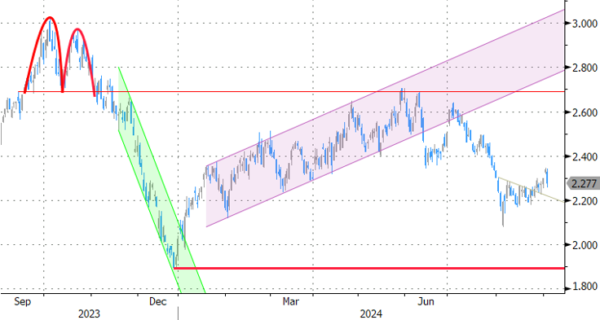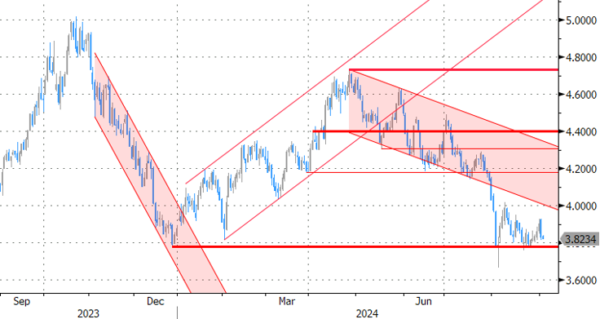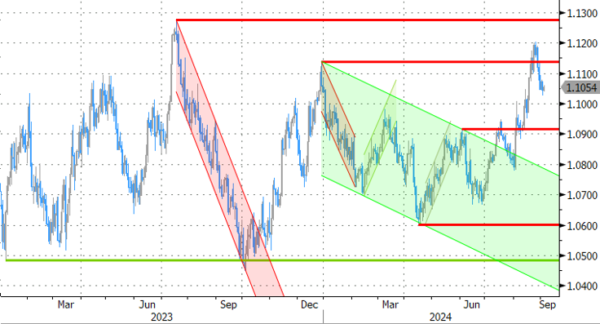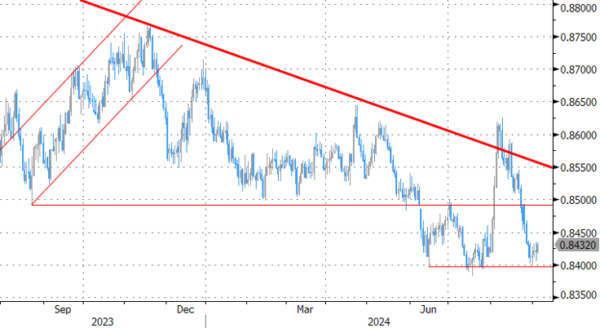Markets
US equities went into a tailspin yesterday. The tech-heavy Nasdaq underperformed, racking up losses of 3.26%. Europe’s EuroStoxx50 (-1.22%) painted the perfect bearish engulfer. Volatility spiked with the Vix index jumping to the highest level since the early August market tremors. Stock markets staged an impressive comeback since that meltdown with some indices on Wall Street even eyeballing the previous record highs. Lofty valuations based on a soft landing scenario in the US made them vulnerable for profit-taking. Against that backdrop, yesterday’s unconvincing US manufacturing ISM put markets on edge in the run-up to the remaining, more important publications that include the services ISM and the payrolls report. We also note the further steep decline in commodities (iron, oil …) which markets in current circumstances take as a sign of weak global demand. Risk-off spilled over to core bond markets with yields tumbling between 5.1 and 8 bps in the US and 4.1-7.3 bps in Germany. The 10-yr in the latter more than reversed Monday’s leap higher. Moves in currency markets were as you would expect with the Japanese yen (USD/JPY 145.48), the Swiss franc (EUR/CHF 0.939) and the US dollar (EUR/USD 1.104) securing the top three. Commodity-related currencies such as the AUD, NOK and NZD continue to trade in the defensive.
Yesterday’s price action tells a lot about markets’ state of mind. The balance of risks (in terms of market reaction) has shifted and we think that data releases in line or below market expectations are likely to trigger the largest moves. With about 35 bps of rate cuts priced in for September, there’s additional room towards a 50 bps cut to discount. Today’s JOLTS report could further add to those bets. The downside in core/US yields looks vulnerable with both the US 2-yr and 10-yr near or actually testing the previous August (ex. Aug 5) lows. A break lower would substantially deteriorate the technical picture and with it alter Fed easing expectations, not only for next week but also further out. We stick to the idea that it’s going to be up to Friday’s payrolls to settle the debate though. The dollar would pay a heavy price if the aforementioned unfolds. From a daily perspective we hold a neutral dollar view.
News & Views
Growth in Australia for the third straight quarter printed at a mediocre 0.2% Q/Q and 1.0% Y/Y in Q2. GDP rose 1.5% in the financial year 2023-24. “Excluding the Covid-19 pandemic period, annual financial economic growth was the lowest since 1991-92, the year that included the gradual recovery from the 1991 recession” the Australian Bureau of Statistics assessed. Household spending fell 0.2%, detracting 0.1 ppt from the overall growth. Government spending rose 1.4% Q/Q on continued strength in social benefits programs for health services. Investment (-0.1% Q/Q) fell for the third consecutive quarter. Changes in inventories detracted 0.3 ppts from growth. Net exports contributed 0.2 ppts to growth as exports grew (0.5%) and imports declined (-0.2%). The combination of subdued growth and at the same time ongoing high domestic prices increases and low productivity are a difficult mix for the RBA which until now signaled no room for a rate cut anytime soon. The Aussie dollar loses some further ground this morning after yesterday’s sharp risk-off repositioning (AUD/USD 0.67).
Economic growth in Brazil surprised to the upside in the second quarter, accelerating to 1.4% Q/Q from 0.8% in Q1. Activity was 3.3% higher compared to the same quarter last year. Activity in industry rose 1.8% Q/Q (despite a decline in mining activity) and services grew 1.0%. On the demand side, domestic demand components contributed positively to overall growth but net exports again were a drag (household consumption 1.3% Q/Q, government consumption +1.3%, investment +2.1% exports of goods and services +1.4% and imports +7.6%). In a comment after the release the Brazil Finance Ministry indicated that it might raise the annual growth forecast beyond 2.7% or 2.8% (was 2.5% in July). Strong activity data support the case for the central bank to raise the policy rate at the September meeting.
Graphs
GE 10y yield
The ECB cut policy rates by 25 bps in June and will likely do so again in September. Stubborn inflation (core, services) warrants a cautious approach on follow-up moves. Markets price in two to three more cuts for 2024 as disappointing US and unconvincing EMU activity data rolled in, dragging the long end of the curve down. Yields meanwhile bottomed in the wake of the August market meltdown, preluding a technical correction higher.
US 10y yield
The Fed in its July meeting paved the way for a first cut in September. It turned attentive to risks to the both sides of its dual mandate as the economy is moving to a better in to balance. Markets juggle between 25 and a 50 bps lift-off. The pivot weakened the technical picture in US yields with another batch of weak eco data pushing the 10-yr sub 4%. Powell at Jackson Hole didn’t challenge markets’ positioning.
EUR/USD
EUR/USD moved above the 1.09 resistance area as the dollar lost interest rate support at stealth pace. US recession risks and bets on fast and large (50 bps) rate cuts trumped traditional safe haven flows into USD. EUR/USD 1.12 was tested but survived. A (technical) dollar comeback then kicked in.
EUR/GBP
The BoE delivered a hawkish cut in August. Policy restrictiveness will be further unwound gradually on a pace determined by a broad range of data. The strategy similar to the ECB’s balances out EUR/GBP in a monetary perspective. Recent better UK activity data and a cautious assessment of BoE’s Bailey at Jackson Hole are pushing EUR/GBP lower in the 0.84/0.086 range.
















